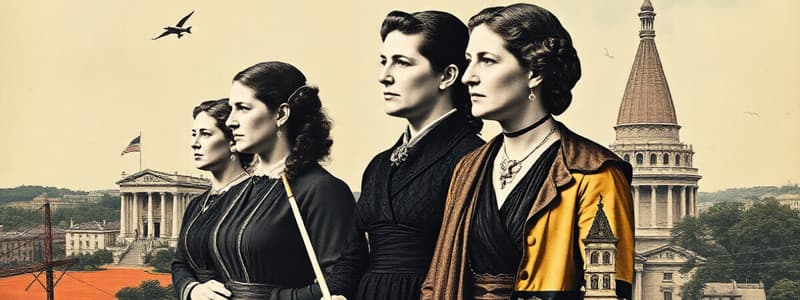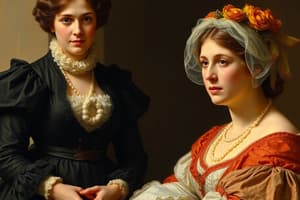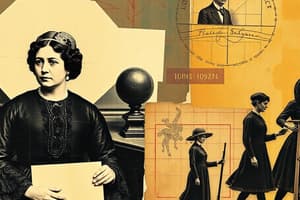Podcast
Questions and Answers
How did Elizabeth Cady Stanton challenge prevailing societal norms regarding women's roles during her time?
How did Elizabeth Cady Stanton challenge prevailing societal norms regarding women's roles during her time?
- By primarily focusing on reforming laws related to property rights for married women.
- By advocating for women to prioritize domestic duties and childcare over political participation.
- Through writing and reinterpreting religious texts to counter the notion of female inferiority. (correct)
- By exclusively engaging with male political figures to influence policy decisions.
Why did Julia Howe and Lucy Stone form the American Woman Suffrage Association, a splinter group?
Why did Julia Howe and Lucy Stone form the American Woman Suffrage Association, a splinter group?
- They disagreed with other suffragists on strategies for gaining media attention.
- They were in favor of prioritizing suffrage only for white women.
- They supported granting the vote to African American men, even if women's suffrage was delayed. (correct)
- They believed women should manage suffrage associations independently from men.
What was the significance of the Seneca Falls Convention in 1848, particularly concerning Elizabeth Cady Stanton's role?
What was the significance of the Seneca Falls Convention in 1848, particularly concerning Elizabeth Cady Stanton's role?
- It led to the immediate passage of laws granting women equal property rights across all states.
- It was the first time women were allowed to vote in a national election due to Stanton's efforts.
- It was a pivotal event where Stanton, among other women, organized and advocated for women's rights, leading to the Declaration of Sentiments. (correct)
- It marked the beginning of the abolitionist movement in the United States, spearheaded by Elizabeth Cady Stanton.
How did societal expectations of women impact Julia Howe's early writing career?
How did societal expectations of women impact Julia Howe's early writing career?
How did the partnership between Elizabeth Cady Stanton and Susan B. Anthony contribute to the women's suffrage movement?
How did the partnership between Elizabeth Cady Stanton and Susan B. Anthony contribute to the women's suffrage movement?
How did Julia Howe balance her personal life and suffrage activism, based on the information provided?
How did Julia Howe balance her personal life and suffrage activism, based on the information provided?
What was the cause of friction between Stanton, Anthony, and certain African American leaders after the Civil War?
What was the cause of friction between Stanton, Anthony, and certain African American leaders after the Civil War?
What did Elizabeth Cady Stanton mean when she described her experience as a 'prisoner' despite her dedication to motherhood and family life?
What did Elizabeth Cady Stanton mean when she described her experience as a 'prisoner' despite her dedication to motherhood and family life?
What criticism did suffragists face, according to the information?
What criticism did suffragists face, according to the information?
From what you have read, what was a significant challenge Julia Howe faced within her marriage?
From what you have read, what was a significant challenge Julia Howe faced within her marriage?
What was the primary reason Lucy Burns and other suffragettes demanded to be recognized as political prisoners rather than criminals?
What was the primary reason Lucy Burns and other suffragettes demanded to be recognized as political prisoners rather than criminals?
How did Lucy Burns, along with other suffragettes, leverage President Wilson's speeches on democracy to further their cause?
How did Lucy Burns, along with other suffragettes, leverage President Wilson's speeches on democracy to further their cause?
Considering the overall impact of the 'Night of Terror', what conclusion can be drawn about the suffragettes' strategy?
Considering the overall impact of the 'Night of Terror', what conclusion can be drawn about the suffragettes' strategy?
What was the significance of Lucy Burns’s decision to retire from public life after the passage of the Suffrage Act of 1920?
What was the significance of Lucy Burns’s decision to retire from public life after the passage of the Suffrage Act of 1920?
How can Alice Paul's commendation of Lucy Burns as "a thousand times more valiant than I" be interpreted in the context of their activism?
How can Alice Paul's commendation of Lucy Burns as "a thousand times more valiant than I" be interpreted in the context of their activism?
Which of the following best describes Nina's approach to the suffrage movement in New Mexico?
Which of the following best describes Nina's approach to the suffrage movement in New Mexico?
How did Nina contribute to the preservation of Hispanic culture in the Southwest?
How did Nina contribute to the preservation of Hispanic culture in the Southwest?
What was the primary reason Nina was denied the opportunity to run for the U.S. House of Representatives in 1922?
What was the primary reason Nina was denied the opportunity to run for the U.S. House of Representatives in 1922?
What can be inferred about the political climate in New Mexico during Nina's time as a suffragist?
What can be inferred about the political climate in New Mexico during Nina's time as a suffragist?
What impact did Nina's activism have on women in New Mexico?
What impact did Nina's activism have on women in New Mexico?
Flashcards
The Woman's Bible
The Woman's Bible
A controversial book by Elizabeth Cady Stanton challenging traditional views of women in the Bible.
Seneca Falls Convention
Seneca Falls Convention
A meeting in 1848 organized to discuss and advance women's rights.
Declaration of Sentiments
Declaration of Sentiments
A document authored by Elizabeth Cady Stanton, outlining grievances and demands for women's rights.
Women's Suffrage
Women's Suffrage
Signup and view all the flashcards
Susan B. Anthony
Susan B. Anthony
Signup and view all the flashcards
Samuel Howe
Samuel Howe
Signup and view all the flashcards
Passion-Flowers
Passion-Flowers
Signup and view all the flashcards
American Woman Suffrage Association
American Woman Suffrage Association
Signup and view all the flashcards
The Woman's Journal
The Woman's Journal
Signup and view all the flashcards
Suffragists' Challenges
Suffragists' Challenges
Signup and view all the flashcards
Suffragette Prison Treatment
Suffragette Prison Treatment
Signup and view all the flashcards
Night of Terror (1917)
Night of Terror (1917)
Signup and view all the flashcards
Hunger Strike
Hunger Strike
Signup and view all the flashcards
Suffrage Protest Tactics
Suffrage Protest Tactics
Signup and view all the flashcards
Lucy Burns' Post-Suffrage Role
Lucy Burns' Post-Suffrage Role
Signup and view all the flashcards
Who was Nina?
Who was Nina?
Signup and view all the flashcards
Nina's Educational Role
Nina's Educational Role
Signup and view all the flashcards
Nina's Civic Roles
Nina's Civic Roles
Signup and view all the flashcards
"Old Spain in Our Southwest"
"Old Spain in Our Southwest"
Signup and view all the flashcards
Nina's Lasting Impact
Nina's Lasting Impact
Signup and view all the flashcards
Study Notes
Jeannette's Early Life and Career
- Jeannette was impatient with domestic life
- Jeannette urged herself to seize every opportunity in her diary
- Jeannette graduated from Montana State University in 1902
- After graduation Jeannette explored teaching but quickly grew bored
- For a change of pace Jeannette worked as a milliner, which allowed her to express her creativity
- Jeannette was known for her regal manner and outrageous, wide-brimmed hats
- In 1907, at age 27, Jeannette moved to San Francisco to work in social work
Social Work and Suffrage
- Jeannette enrolled in a social worker's course in New York City
- Jeannette was horrified by the conditions in urban slums
- Jeannette relocated to Spokane, Washington and Seattle to continue her social work studies
- Jeannette discovered her true cause in Seattle
- Jeannette spotted a poster seeking volunteers for suffrage work in Washington State
Political Career
- In 1910, Jeannette began working for suffrage in Washington State
- In 1911, Jeannette returned to Montana and pressed for reforms in Missoula's judicial and prison systems
- Jeannette organized local suffrage groups
- On February 1, 1911, Jeannette was the first person to address Montana's state lawmakers about suffrage
- Jeannette's success in grassroots organizing soon had her working at the national level
- Montana granted women the right to vote in 1914
Temperament and Ambition
- Jeannette's passion caused trouble at times, and she sometimes lost her temper
- One night at a suffrage office she threw things and scolded later by a friend
- Jeannette had an idea to run for Congress as Montana had two seats in the House of Representatives
- Jeannette believed that she could win an election there even if she came in second
- Jeannette's brother, a lawyer, agreed to help run her campaign
Hattie Wyatt Caraway
- Hattie Wyatt Caraway of Arkansas was the first woman elected to the U.S. Senate
- She was appointed to her husband's seat when he died in office in 1931
- She subsequently won election to the seat in 1932 and again in 1938
Studying That Suits You
Use AI to generate personalized quizzes and flashcards to suit your learning preferences.




